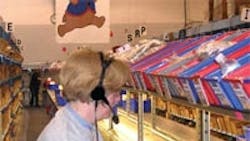Awana’s (Streamwood, Ill., www.awana.org) 82,000- sq.-ft. distribution center in Schaumburg, Ill., ships directly to registered churches and stocks 2,400 items, ranging from books and pamphlets to games, trophies, apparel, and small novelty items such as pens, pins, stickers and bookmarks. The DC handles more than 160,000 orders per year, with an average of nineplus items per order. It averages 20 items per order during its peak season from August to October. To better serve customers and improve efficiency, the non-profit organization has implemented voice technology throughout the DC.
Seven years ago, it took Awana 11 days to ship an order. “We started making a lot of changes to meet the goal of ‘out the door in 24 [hours],’” explains Steve Hale, director of distribution. The company added a second shift and hired temporary workers during its busy season. These changes enabled Awana to cut its shipping time to one day for 99% of orders, but created new problems. “When we brought in temps, there were tons of errors,” Hale says.
Following its paper-based process, products were picked and sent to packing stations where 70% of orders were audited. During the busy months, only 50% were checked before shipping. As a result, many orders were shipped with errors at an estimated $13 cost per error.
The problem was alleviated with the implementation of voice-picking technology from Lucas Systems (Sewickley, Pa., www.lucasware.com). Awana chose to use the voice system from Lucas, named Jennifer, because of its lower cost, the promise for a faster return on investment, and easy acceptance by employees. Installed in 2004, use of the system expanded incrementally in 2005 and 2006. Awana now uses voice technology to support receiving, replenishment and returns processing.
Flawless Implementation
The implementation process was lead by a team of Lucas engineers and Awana staff. Lucas took the lead by asking questions, setting parameters and determining what needed to be accomplished before the system was deployed. The information collected was used to create an engineering study that was used to guide the implementation of the voice-directed picking system.
Lucas customized the technology to fit Awana’s order fulfillment processes and requirements. Included were new label printing, short filling and quality control capabilities. Hale says he was pleased that the Lucas engineers did not propose any changes to his operations unless the change could improve processes already in place.
“The implementation was flawless. The key is to manage the project closely and keep an eye on the milestones. You must have someone on your side that knows your system inside and out. You can’t just expect the vendor to do it all,” Hale says.
The voice system tells order pickers which items and what quantities to pick. Pickers verbally confirm (using a three-digit check string printed on the item location) the quantities and items as they are placed in the appropriate tote for the order. According to Hale, verbal confirmation plays a big part in improving accuracy— incorrect counts were its number-one cause of errors. Pickers also tell the system if a slot is empty. The system immediately relays that information to managers and employees at a short filling area.
Besides voice picking capabilities, Lucas also helped install quality control functions using barcode scanning at the packing stations. From a maximum of 70% order accuracy before voice technology, Awana is now checking every order that ships. “Our order accuracy out the door is virtually 100%,” Hale says.
Accuracy and productivity gains resulting from the voice technology exceeded expectations. “Jennifer paid for itself in less than 13 months, and we didn’t even capture the full cost benefits of fewer errors.”
Beyond Order Picking
In 2005, Awana started rolling out Jennifer in other areas. “While accuracy was the main goal of the picking application, productivity was the big driver for adding voice in returns, receiving and replenishment,” Hale says.
Previously, employees in the returns area would manually look up customer and product codes and tag each returned item with the appropriate location. With the voice technology, they say the customer or invoice number and the item number, and the system instructs them to place the item in a numbered tote.
